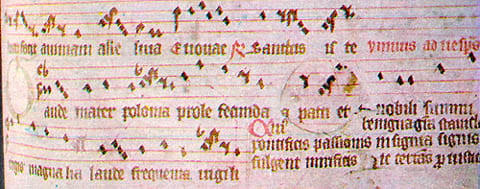Essay by Maja Trochimczyk
Gaude, Mater Polonia – the most popular medieval Polish hymn – is a fragment of the rhymed breviary office written by Wincenty of Kielce on the occasion of St. Stanislaus beatification (1253).
Its text praises St. Stanislaus, a bishop whose 1072 death was the result of a confrontation with the King, Boleslaus the Bold (Bolesław Smialy). (The parallels with the fate of St. Thomas Beckett are rather obvious.) That is why Gaude, Mater Polonia, although the name of the country appears in its title, asserts the primacy of religious authority over royal power.
This hymn was very popular and can be found in the diocesan manuscripts and prints Poland-wide. As the only medieval Polish hymn in Latin it was included in Polish hymn-books in the 17th century. The oldest known record of the melody, deliberately taken from another hymn Gaude, mater ecclesia, is found in the Kielce antiphonary (1372).
In the 19th century, Teofil Klonowski elaborated a four-part song wchich played a role of the national anthem for many decades and may be currently found in the repertoire of all Polish choirs at home and abroad.
Text (fragment)
Gaude, mater Polonia / prole foecunda nobili,
Summi Regis magnalia laude frequenta vigili. Amen.
Cuius benigna gratia / Stanislai Pontificis
Passionis insignia signis fulgent mirificis. Amen.

Sources of Material
This entry is based on Wlodzimierz Soltysik, Polskie Hymnt Narodowe/Polish National Anthems (Warsaw: Triangiel KOMO-GRAF, 1996). Publisher’s address: P.O. Box 183. 00-950 Warszawa 30, POLAND; tel/fax: 011-48-22 — 722 20 30.
The recording is from Boze, cos Polske CD, performed by Cappella Cracoviensis, conducted by Stanislaw Gałoński. The CD is by State Folk Dance Group Mazowsze, issued by Polskie Nagrania, ECD 034.
The 19th-century postcards of symbolic imagery and Polish emblems are from Maja Trochimczyk Collection.
